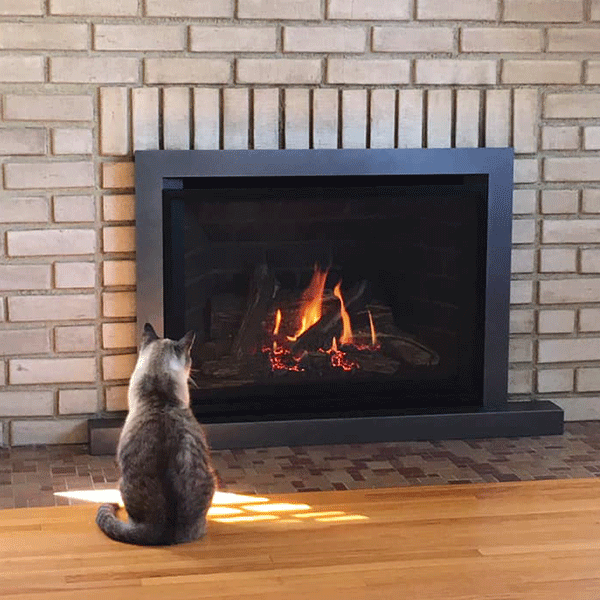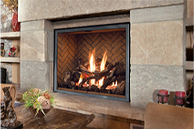How to Convert a Masonry Fireplace to Gas
Wood-burning fireplaces are timeless and beautiful focal points for many homeowners. But, wood fireplaces are terribly inefficient and can be a pain to maintain. One way people solve these problems while maintaining the aesthetics of a wood-burning fireplace is to convert them to gas. In this post, we’ll look at how and why you might consider going down this road if you have a masonry fireplace.

Gas Insert versus Wood Fireplaces
As mentioned, many homeowners are turning to gas fireplaces as an alternative to traditional wood-burning fireplaces by retrofitting them with a gas insert. Gas offers several benefits over wood while maintaining the same warmth and atmosphere. Here are some facts if you’ve never considered upgrading to a gas insert.
Gas is More Efficient
Gas inserts are more energy efficient than traditional fireplaces. How much more? Well, a typical wood-burning fireplace loses up to 90% of the heat up the chimney in-stead of warming your home. That’s a lot of wasted energy and money. On the other hand, gas is up to 85% more efficient, allowing you to stay warmer without draining your wallet.
Gas Inserts are Easier to Use
If you own a wood-burning fireplace, you know how challenging it is to maintain. Wood-burning fireplaces require regular chimney sweeping to remove dangerous creosote buildup, and you must keep a steady supply of wood ready to use for fuel. Moreover, starting a fire in a wood-burning fireplace can sometimes be a chore
>Upgrading to a gas fireplace insert makes owning a fireplace a lot easier. Gas doesn’t produce creosote or ash like wood, so less chimney and fireplace cleaning is required. Also, most gas fireplaces start up with the push of a button or flip of a switch. Finally, as stated, gas fireplaces are more energy efficient, allowing you to control the amount of heat output when you want to save more energy.
How to Convert a Wood Fireplace to Gas
If you’re sold on the benefits of upgrading your wood fireplace to gas, here are the steps to get it done.
Consult a Pro
The first thing to do is hire a professional chimney and fireplace service for a full inspection of your chimney to clear away creosote and check for damage to the masonry or flue. Although gas doesn’t produce the amount of creosote as wood, you still need a clean flue and a healthy chimney.
Install or Upgrade Your Gas Line
If you don’t have a gas line, you’ll have to have one installed. If you do, you must ensure it’s the right size to allow the proper amount of gas flow to operate the fire-place efficiently and according to the manufacturer’s specifications. It’s recommend-ed you hire a professional gas fitter for this because of the risk involved in doing a shoddy DIY installation.
Choosing the Right Insert
Once you have the gas lines in place and your chimney is clean and safe, you’ll have to decide which type of insert you want. Regarding gas fireplace inserts, you have sever-al options; the most common is a direct vent.
Direct-Vent
A direct-vent gas fireplace insert draws air from and exhausts the combustion gas out-side; this is a viable option for people looking for energy efficiency.
Vent-Free
Vent-free gas fireplaces provide heat without having to directly vent the gas out-side because they rely on unvented combustion technology.
Unvented combustion uses oxygen from inside the house and returns the combustion gas back inside. Vent-free fireplaces are easier to install because they don’t require a venting system (such as a chimney) to be installed. Because the gas isn’t venting outside, homeowners must use carbon monoxide detectors to monitor for toxic gas.
The bottom line is that if you don’t currently have a venting system and don’t want the additional expense, the vent-free option is the way to go. However, direct vent inserts are safer, even if you lose some heat energy through the flue.

Contact Twin City Fireplace
We’re a family-owned company that’s committed to providing outstanding customer service and top-rated chimney and fireplace services for residents throughout Minnesota. We specialize in the sales, service, and installation of gas and wood-burning fireplaces, and offer professional brick and stone installation, construction, and design.
You can trust our work because we employ licensed general contractors, gas fitters, and skilled masons and artisans for a seamless sale-to-installation process.
 Active-Duty Military Owned
Active-Duty Military Owned








